|
The STAR
WARS Role
|

From the
Guardian [51] |
The Campaign for the Accountability of
American Bases (CAAB) [52] have continually monitored the planning
applications made by the Ministry of Defense Land Agent (Defence
Estates’ Organisation, Catterick Garrison - on behalf of the US
Government) for Menwith Hill to Harrogate Council for over 10 years.
Planning applications are submitted to
Harrogate Council for information only, they have no power of veto.
It may, however (if it receives sufficient objections) initiate
proceedings which may lead to a public enquiry. In 1996 CAAB learned
that a significant development was to take place at MHS. Some time
later they found a press release tucked away in a file for two
radomes, which said:
"HMG [Her Majesty’s Government] and
the United States Government are pleased to announce that the
European Relay Ground Station (RGS-E) for the new Space Based
Infra-Red System (SBIRS) will be established at RAF Menwith
Hill. The RGS-E will provide additional relay capability of
SBIRS, and its establishment at RAF Menwith Hill will
capitalize
on the existing infrastructure. HMG welcomes the opportunity to
strengthen US/UK co-operation in this field.
SBIRS is the world-wide
satellite-based system providing early warning of ballistic
missile launches. It has been developed to upgrade the ageing US
Defense Support Program (DSP) satellite system. Construction
will include a one-storey 10,000 square feet concrete and steel
building adjacent to and architecturally blending with the
existing building. Up to four new radomes approximately 60 feet
in height and similar to the existing radomes will also be
required. Local planning consent will be sought in the usual
way."
Menwith
Hill would soon be the home for the European Relay Ground Station
for the New Space Based Infra Red System
[53].
This system is part of the US plan to adopt "Son of Star Wars"
[54].
The radomes for the Space Based Infra Red System (SBIRS)
[55] are
now built. General Howell M. Estes III (Commander in Chief, North
American Aerospace Defense Command and US Space Command and Air
Force Space Command, Commander) has said in a speech urging the US
Congress to "help fulfill the promise of space"
[56] that:
"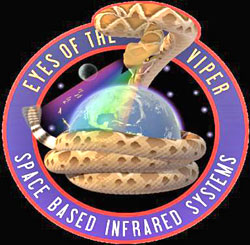 Our
SBIRS system consolidates DoD’s
non-imaging infrared systems that fulfill national security
needs in areas of missile warning, missile defense, technical
intelligence and battlespace characterization. It consists of
high and low components. We need to get SBIRS High on-orbit
first as a replacement for the Defense Support Program (DSP).
We’re going to put four satellites up to replace four DSPs. Our
SBIRS system consolidates DoD’s
non-imaging infrared systems that fulfill national security
needs in areas of missile warning, missile defense, technical
intelligence and battlespace characterization. It consists of
high and low components. We need to get SBIRS High on-orbit
first as a replacement for the Defense Support Program (DSP).
We’re going to put four satellites up to replace four DSPs.
This will improve our location
identification and tracking capabilities by better identifying
the missile launch point, impact point and azimuth. It will also
give us another level of refinement in those areas as we work
the missile defense issue. The advantage of SBIRS Low is that it
can track "cold bodies" in space.
SBIRS Low is important for the
ballistic missile defense systems. With SBIRS High, you can only
track infrared signatures which means the rocket motor has to be
burning. These systems will significantly improve our ability to
provide much more precise launch and impact point of theater
missiles to forces in a theater of operations. They are key to
our ability to cue systems that we’ll use for active defense as
part of both theater and national missile defense."
In December 1998 the Star Wars role of
MHS was further exposed on television by Richard Sadler
[57] and in
October 1999 Lindis Percy of the Campaign for the Accountability of
American Bases made an application for a Writ to stop this
construction. The Writ (later a Claim) was issued by the High Court
against four defendants:
-
Colonel Clyde D Harthcock -
American base Commander at MHS at that time
-
Secretary of State for Defence -
he is in possession of the land
-
Defence Land Agents - deals with
all planning applications for American ’clients’ and
oversees building etc
-
Squadron Leader Humphrey Vincent
- RAF Liaison officer.
 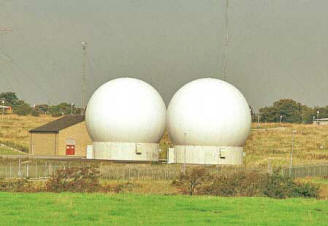
SBIRS dishes and
radomes (project GRAPNEL) at Menwith Hill (photos by Craig Stennett
for CAAB)
[52]
The American Base Commander successfully
claimed immunity from UK court proceedings under the "Visiting
Forces Act". The other defendants contested that the claim be struck
out on the grounds of ’Abuse of Process of the Court’. However, the
High Court decided the Claim should be heard. Eventually however,
President Clinton’s decision on 1 September 2000 to leave the fate
of the NMD programme to his successor, forced CAAB to withdraw the
writ after all [58]. The First Defendant
 is
now claiming £16,173.06p costs and the 2/3/4 Defendants are claiming
£11,000 costs against Lindis. However, CAAB will still continue with
this action, and Fylingdales was later included in the Claim as
another base to be used as part of ’Son of Star Wars’
[59]. is
now claiming £16,173.06p costs and the 2/3/4 Defendants are claiming
£11,000 costs against Lindis. However, CAAB will still continue with
this action, and Fylingdales was later included in the Claim as
another base to be used as part of ’Son of Star Wars’
[59].
On 18 January 2000, Ann Cryer (Bob Cryer’s widow) now also a Member
of Parliament, made a speech in the House of Commons that
highlighted the US Space Command’s vision to be "Masters of Space"
[60]. Now - with the election of
George W Bush to the US presidency
and the appointment of Dennis Rumsfeld as Secretary of Defense - the
US development of a Star Wars (or National Missile Defense)
programme is almost certain. Menwith Hill’s role in these plans is
well recognized - the debate and protest continues
[61].
Two radomes for SBIRS [98] were in fact built even before the US
gave notice to withdraw from the Anti-Ballistic Missile Treaty with
Russia. However, the SBIRS High infrared detection system has become
one of the US Defense Department’s biggest white elephants - the
SBIRS-High Increment 1 software was finally installed at Buckley Air
Force Base in Aurora, Colo., almost two years late, but the
satellites themselves are plagued with problems involving the
infrared detection system.
In 2002 the name for SBIRS Low infrared tracking system was changed
to:
"The Space-Based Tracking and
Surveillance System” [99]
There is no doubt that, through its
communication, relaying and eavesdropping capabilities, Menwith
plays an important role in helping the US military in its plans to
dominate and control space, despite the effects on International
Treaties (such as the ABM Treaty, the Outer Space Treaty and the Non
Proliferation Treaty) and the mistrust and concern expressed by
people and their governments all over the world
[62].
Go Back
SIGINT
and War Fighting
Major General Judd Blaisdell, director of space operations and
integration at the Pentagon has described how the US Air Force is
using space to enhance its intelligence, surveillance and
reconnaissance (ISR) capabilities:
“During Operation Iraqi Freedom,
various ISR assets provided information to the combined air
operations centers, allowing them to make rapid battlefield
decisions, putting coalition forces inside the enemy’s decision
cycle.” [100]
The US military has described
space-based intelligence collection as a “key force-multiplier for
future military operations”. The close linkage between space-based
intelligence collection and military operations was clearly spelt
out in congressional testimony a few years ago by the then Director
of the National Reconnaissance Office:
"In the future, US forces
will rely upon space systems for global awareness of threats, swift
orchestration of military operations, and precision use of smart
weapons. ... Our goal is to detect, track and target anything of
significance worldwide and to get the right information to the right
people at the right time."
The objective is to enable the US
military to deliver "precise military firepower anywhere in the
world, day or night, in all weather".
Intelligence collection is the foundation for war planning. Together
with high-resolution satellite imagery, signals intelligence played
a vital role in identifying military targets in Iraq. Signals
intelligence was used to identify key Iraqi military command,
control, communications and intelligence facilities that became
priority targets for the US offensive.
Australian personnel at Pine Gap and UK personnel at Menwith Hill
were intimately involved in these processes.
SIGINT and The Gulf War
[101]
The importance of the monitoring and collection of SIGINT during
times of ‘international tension’ is obvious and Menwith Hill
station received an award for its support to US naval operations
in the Persian Gulf from 1987 to 1988. In 1991, a further award was
given for support of the Iraqi war operations, Desert Storm and
Desert Shield. [102]
SIGINT provided one of the first indicators of Iraqi intentions in
Kuwait:
"A Soviet-built TALL KING radar that
abruptly resumed operation Sunday morning, July 29, in southern
Iraq gave US analysts their first substantive warning that the
Iraqi invasion of Kuwait was likely."
The 350 mile range radar had been out of
service for a number of months prior to the invasion.
[103]
An intensive signals intelligence campaign mounted in the later part
of August 1990 was expected to provide 12 to 24 hours advance notice
of an Iraqi attack. In October it was reported that:
"US electronic listening posts -
including AWACS, intelligence ships, and ground stations - have
been somewhat successful in monitoring Iraqi military
communications. But much of the Iraqi army has been using
underground cables to communicate between Baghdad and Kuwait.
The secure communications have made it difficult to determine
Iraqi military intentions... the Iraqis took steps to secure
their communications several years ago after a US newspaper
disclosed details of a US electronic eavesdropping operation
against Iraq." [104]
Later in October:
"electronic intelligence operations
in the region detected the first characteristic signs of Hawk
radar operation at a special test site for air defense equipment
near Baghdad. The radar emanations indicated that Iraq is
’playing around’ with the weapons systems, as one official put
it, but still remains weeks to months away from actually
deploying them." [105]
And:
"US intelligence collected in
November (revealed) that a Soviet military officer was overheard
giving orders on an Iraqi military radio channel in Kuwait. The
US intercept, picked up in southern Kuwait, sounded like a
Soviet officer directing an Iraqi tank battalion... The
information was collected by the US National Security Agency and
reported secretly within the US government. A subsequent
intelligence report said Britain’s electronic intelligence
agency disputed the veracity of the intercepted communication
and said the report was ’under further analysis’."
[106]
Signals intelligence systems also
provided warning of impending Iraqi Scud missile launches. The
missile launchers:
"have a radar …. used to track a
balloon sent into the upper atmosphere just before launch to
help compute high altitude winds and increase accuracy of the
missile." [107]
Also, one way of assessing the
effectiveness of bomb damage is to monitor the amount of radio
traffic after attack. [108]
In early February 1991 it was reported that:
"for the first time, some Guard
units have broken radio silence, enabling US intelligence to
study their codes and deduce that they are under pressure."
[109]
A little while later it was reported
that:
"many Iraqi troops are being forced
to communicate outside of secure networks on regular VHF radio
channels, which are far easier for allied intelligence gatherers
to intercept... such open communication could allow allied
special forces teams to infiltrate Iraq’s airwaves with false
battle orders designed to confuse Iraqi troops."
[110]
Also in early February, it was reported
that Soviet advisors were providing the Iraqi,
"military with information about the
times US spy satellites pass overhead... The information on the
Soviet action was gathered from what the sources described as an
’extremely sensitive source,’ a term often use to describe
communications intercepts." [111]
SIGINT was also central to efforts to
attack Iraqi leadership assets, including Saddam Hussein himself.
"Saddam has changed his daily
routine and movements as a result of disclosures that US air
forces had targeted him, his family, his mistress and members of
his family." [112]
SIGINT was instrumental in the
identification of the Amiriya bomb shelter in Baghdad which was
alleged to have sent signals from the shelter to a remote antenna
via cable in order to avoid disclosing the location.
[113] Despite
there being limited photographic coverage, apparently "intercepts of
military communications from the shelter were monitored" close to
the actual bombing which killed hundreds of civilians on 12 February
1991. However, a,
"Pentagon official, who asked not to
be named, suggested that the installation was not broadcasting
its messages by antenna. Rather, this official implied, that the
center used buried communications lines to transmit its
messages, which were later relayed to forces in the field."
[114]
Following the controversy that
surrounded the bombing, "some political leaders pushed to release
intercepted radio signals from the site,"
[1] but this never
happened.
American skepticism concerning Iraq’s offer on15 February to
withdraw from Kuwait, subject to a number of conditions, was
reinforced by signals intelligence.
"... radio intercepts overheard no
orders going out from Baghdad telling Iraqi commanders the war
is nearing an end...” [116]
Another use of SIGINT is highlighted
when:
"Days before the start of the ground
war, the forces began dropping 15,000 pound ’Daisy Cutter’ bombs
on Iraqi troops from the back of C-130 transport planes....
Terrified Iraqis were certain that the devastating explosion
signaled the beginning of the ground war, and turned on their
air-defense radars all along the boarder. American pilots
pinpointed many air-defense installations they never new
existed. Says one Pentagon official, ’We were able to ’paint’
every radar electronically and knock them out.’"
[117]
According to Professor Des Ball of the
Australian National University, during the Gulf War satellites
controlled by Menwith Hll’s sister base at Pine Gap intercepted
Iraqi communications and radar signals. These satellites monitored
critical communications channels within Iraq, including those used
by the Iraqi military high command.
The close linkage between space-based intelligence collection and
military operations was clearly spelt out in congressional testimony
four years ago by the then Director of the National Reconnaissance
Office:
"In the future, US forces will rely
upon space systems for global awareness of threats, swift
orchestration of military operations, and precision use of smart
weapons. ... Our goal is to detect, track and target anything of
significance worldwide and to get the right information to the
right people at the right time."
The objective then is to enable the US
military to deliver "precise military firepower anywhere in the
world, day or night, in all weather". [118]
The War in Iraq
Even before the war in Iraq began SIGINT was playing a role.
A memo leaked to the Observer in February 2003 claimed that
delegations at the UN Security Council were being electronically
bugged as part of the US government’s efforts to win a second
resolution on Iraq. [119]
Satellite systems were a key component to the execution of the war
on Iraq. During the war the US military was using 10 times the
satellite capacity that it used in 1991.
Nine days before the start of the war in 2003 a new US Defense
Satellite Communications System was installed in space to connect
ground forces, ships, planes, the Pentagon, the White House, the
State Department and the U.S. Space Command.
Over 50 military satellites supported the US and UK war effort. 27
Global Positioning System satellites were available to help
determine the exact location of special operations teams and of
targets. Around 24 satellites were employed to channel
communications and commands and to give warning of missile attack
and there were also weather forecasting, TV and other systems in
operation. A February 2000 flight of the space shuttle Endeavor used
radar to produce a 3-D map of targets in Iraq.
[120]
The director of space operations for the US Air Force, Maj. Gen.
Judd Blaisdell, has estimated that 33,600 people at 36 sites around
the world are involved in space-war activities.
There were problems with the technology. At least 2 Tomahawk
missiles missed their targets and landed in Saudi Arabia and Turkey
by mistake, but also the availability of radio bandwidth (the range
of frequencies that can be used) was found to be insufficient.
On Tuesday 22nd April 2003 the US Air Force set up the 614th Space
Intelligence Squadron at Vandenberg Air Force Base in California. In
a short formal ceremony the commander, Lt Col Earl White made the
following statement:
"Everybody in the world has been
watching this Iraq war, and the Gulf War before that," said Lt.
Col. White in an interview after the ceremony. "And they know
what space does for the U.S. military. That is a key enabler.
Without space, we’re back to World War II. Anyone who wants to
take on the United States knows they’ve got to handle us in
space." [121]
Also, Maj. Kurt Gaudette, director of
operations for the new squadron was reported as stating that:
"All smart bombs, and smart weapons,
were controlled by GPS (Global Positioning System)”
And John Pike, director of
globalsecurity.org was quoted as saying:
"The latest war with Iraq was the
space war that the 1991 Gulf War previewed. Space systems are
the key to U.S. military power."
[122]
Menwith Hill had an important role as an
interceptor of and a conduit for intelligence and command
information in the Gulf war and the War on Iraq and its activities
are likely to continue to expand as the US develops more space based
war fighting systems.
Go Back
The
CAMPAIGN of OPPOSITION

An early protest -
Yorkshire Campaigners call for independence
from the NSA at a demonstration on American
Independence Day at Menwith Hill
Opposition to the base has been active
since the 1950s . Most of what we know about the base has been put
together from various sources by Duncan Campbell. One important
source of information has been that obtained from within the base by
peace campaigners and from their continuous observation and
vigilance. There have also been demonstrations, peace camps,
non-violent blockades, trespass, questions in parliament, letters to
the press and radio and TV coverage. And the protests continue.
Peace Camps
A mixed gender weekend peace camp was
originally set-up by Otley Peace Action Group (OPAG - played a major
role in
 raising
public awareness and protest at MHS in the 1980s) on 29 April 1983 .
At least 10 other weekend mixed peace camps were held at MHS by
other local peace groups. raising
public awareness and protest at MHS in the 1980s) on 29 April 1983 .
At least 10 other weekend mixed peace camps were held at MHS by
other local peace groups.
This eventually led to the setting up of
the permanent mixed peace camp in July 1984 , which existed for
three and a half years until 1987. The campers provided a focal
point for disseminating information about the base to members of the
public. They held numerous demonstrations and entered the base on
many occasions. There were many arrests and appearances in court.
Local peace groups produced many leaflets about the base. OPAG
supported the mixed peace camp and did a weekly food run. Many
people were regularly supported by OPAG in court. Public meetings
and actions at the base were also organized.
[63]
In 1993 Helen John (from Greenham Common Women’s Peace Camp) helped
establish a monthly weekend peace camp outside Menwith Hill, on the
NW corner (’Windy Corner’) of the base, near the Main Gate [64]. A
spectacular silver moonbow on the night of 30 January 1994 inspired
the name ’Moonbow Corner’ for a second campsite on the more visible
SE corner of the base alongside the major A59 road. In May 1994 a
ten day "Amazon Festival" was attended by over 100 women - despite
the rain there were many excursions onto the base. On the last day
the sun shone and 6 women stayed on to set up the full-time "Womenwith
Hill" peace camp.
Frequent arrests for fence cutting, slogan painting inside the base,
blockades and a visible protest outside together with lots of local,
national and international media attention, meant that an eviction
was inevitable. The acquisition of a large mobile home and the
laying of gravel paths and flower beds further demonstrated the
women’s resolve to stay, consequently the North Yorkshire County
Council (NYCC) Highways’ Authority obtained a County Court
Possession Order for Moonbow Corner and the Camp was evicted on 18
April 1995 . 7 women chained to vans were arrested (although all
charges against them were later dropped) and mounds of earth & rocks
were dumped to prevent re-occupation. However the women had already
anticipated the eviction and had moved onto a lay-by ¼ mile to the
east.
The Kettlesing Head lay-by on the A59 proved to be an even better
site for visitors to call and park. The camp grew to 10 caravans,
becoming well established with plenty of local and international
support. There were dozens of arrests for blockading and 33 women
awaited trial for trespassing contrary to the byelaws. 18 peace camp
women have served prison sentences for actions at the base and many
more have been detained.
The Legal Department of the NYCC started proceedings to recover its
land and prevent the establishment of any other peace camps by the
women peace protesters on 26 November 1997 . On the grounds that the
Women’s Peace Camp constituted a danger to the public by being a
distraction to motorists using the A59 highway, and that the camp
was an unlawful incursion onto land belonging to the Highways
Authority.
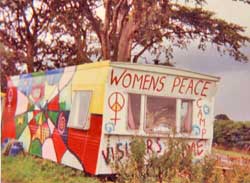  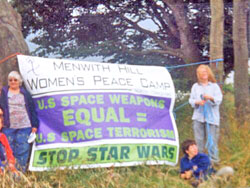
Menwith Hill Women’s
Peace Camp - (pictures from Anne Lee)
On 22 June 1998 , at the High Court in
Leeds, Mr Justice Hooper found the camp to be unlawful and injuncted
three women, Anne Lee, Helen John and Jenny Gaiawyn not to reside
overnight on the site, nor in the vicinity of Menwith Hill. The
Highways Authority went back to the High Court on 29 October 1998 to
seek a Possession Order for the lay-by land. The hearing was
adjourned to allow for new Human Rights legislation to be taken into
consideration. The judge ordered that the camp site be cleared of
all but one token caravan. The women complied with the High Court
Order & removed nine caravans & all equipment from the site on 27
November 1998 [65].
At the hearing on 5 February 1999 it became evident during
cross-examination that the NYCC had withheld documentary evidence of
its collusion with Menwith Hill Station. Mr Justice Hooper ordered
the disclosure of all relevant correspondence. Documents thus
disclosed revealed that the eviction of the Women’s Peace Camp had
been instigated by the Menwith Hill authorities.
Squadron Leader Ted Sumner, RAF (acting as Liaison Officer for the
US National Security Agency) met with Mike Masterman from the NYCC
Environmental Management Department (of which the Highways Authority
is part) on 23 September 1996 . At that meeting Menwith Hill’s
complaints against the camp were discussed, as were ideas on how to
evict the peace camp without appearing to involve the station
authorities. If the NSA were seen to be interfering with the right
of UK citizens to demonstrate, would be embarrassing and politically
damaging.
The women continue to maintain that their right to protest in the
way they choose, by living outside the base, is enshrined in the
European Convention on Human Rights (embodied in The Human Rights
Act 1998) and by recent legal precedents. The judge recognised that
they have a serious and credible cause and on 14 July 1999 allowed
the women the right to occupy the lay-by with an Alternative
Information Centre during the day (from 7am to 11pm every day) but
not to stay over night. The women are currently raising funds for a
vehicle and they still keep up a regular presence there
[66]. More details of
their campaign can be found through newsletters and on the internet.[67]
One way of challenging the legality of the base (and gaining
publicity about what goes on there) is through the courts. Court
actions (involving fence cutting and trespass in particular) have
been used repeatedly by campaigners to bring important issues to
light.
Military Land Byelaws
On 19 February 1996 Menwith Hill was designated ’RAF’ Menwith Hill
in order to validate the military byelaws which apply to UK
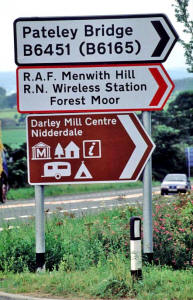 military
bases under the Military Lands Act of 1892. Apparently military
bases under the Military Lands Act of 1892. Apparently
"This was simply an administrative
change to bring the base into line with other RAF sites made
available by the Ministry of Defence to the United States
Government" [68].
The Military Land Byelaws were first
brought in as a reaction to the protest against Cruise missiles at
Greenham Common in April 1985 by the then Secretary of State for
Defence, Michael Heseltine. The intention was to make trespass a
criminal offence and therefore arrestable and so women could be
criminalised to stop their actions of resistance.
Over the years many hundreds of women
were arrested, detained, convicted and imprisoned under these
byelaws. On 12 July 1990 , after a four year journey through the
courts, starting with the Newbury Magistrates and ending in the
House of Lords, the byelaws were held to be ’ultra vires’ - outside
of the Minister’s powers - and, so, ’ab initio’ - from the
beginning. The Greenham byelaws were adjudged to ’interfere with the
rights of common’ and so did not affect the status of the byelaws at
similar bases.
The HMS Forest Moor and Menwith Hill Station byelaws came into force
in 1986 and the first challenge to Menwith Hill in the courts arose
out of a number of arrests made under the military byelaws. The case
against Lindis Percy and John Bugg was heard at Ripon Magistrates’
Court in 1991 . The ruling by Mr J. Barry
[69] (the Stipendary
Magistrate) that the onus of proof of the validity of the byelaws
was on the Prosecution not the Defence, was appealed to the High
Court by the Director of Public Prosecutions. The High Court appeal
was heard on 31 July 1992 and the Judgment by Woolf and Pill
[70]
held for the first time that the byelaws at HMS Forest Moor and Menwith Hill Station were invalid.
Later, as a result of the ruling, some people had their convictions
quashed, and costs were awarded at York Crown Court. The Woolf and
Pill Judgement enabled many people to enter MHS without risk of
arrest during the three years it took before new byelaws were
drafted. In July 1991 the Ministry of Defence Police at MHS stopped
arresting under the byelaws and trespass again reverted back to a
civil offence.
In the mean-time, in 1991 , the Secretary of State for Defence (then
Tom King) tried to sue Lindis Percy for trespass and claimed damages
for £11,600 for ’wasting police time’ at Menwith Hill. This was the
first injunction at Menwith and started as a temporary injunction
and lasted for five years before being made permanent in 1996 .
On 28 August 1991 Mr. Justice Cresswell transferred the case from
the High Court, where the plaintiffs had started it, to the
Harrogate County Court, and from there it was transferred to York
(as the facilities at Harrogate were inadequate). Eventually it was
heard by Judge Crabtree [71] in York County Court in July 1993 .
Judge Crabtree ruled reluctantly (after an application made by the
Secretary of State for Defence) that the case should be sent back to
the High Court. In his ruling Judge Crabtree said that if Ms Percy
was right in her defence it would have meant that all the agreements
and arrangements between the US and British Governments would have
to be renegotiated.
When the case eventually came to the High Court in March 1995 ,
Malcolm Rifkind put on a Public Interest Immunity Certificate
[72],
to prevent documents obtained from inside MHS (to prove that the NSA
was in occupation) from being submitted and the case had to be
conceded. However, a number of documents disclosed as a consequence
of this action revealed the history of how a small group of people
in London made the decision to hand over vast areas of land to the
US visiting forces in the late 40s /early 50s (the "NATO Status of
Forces Agreement"). [73] It was also revealed that the land was
compulsorily purchased at the request of the US. Among the secret
documents disclosed were details of the ’security of tenure’
agreement which allowed the Americans use of the land for 21 years
renewable every 21 years on request of the USAF. There were also
details of how bases should be referred to as ’RAF’ and not USAF.
The byelaws story became tangled when Lindis Percy, John Bugg and
Rachel Greaves brought out a Writ against 66 Ministry of Defence
Police officers and others for unlawful arrest and detention under
the 1986 invalid byelaws. John Bugg died in 1993 after meticulous
and significant work challenging military land byelaws. Lindis Percy
and Rachel Greaves lost the case after the MOD successfully
challenged the Woolf and Pill ruling, which resulted in the 1986
byelaws being declared valid again. An appeal to the House of Lords
by Lindis Percy and Rachel Greaves against this ruling could not be
pursued because legal aid was denied. This resulted in the somewhat
farcical situation whereby the people who had had their convictions
quashed should have technically been found guilty again!
In a written answer to Max Madden MP on 24 October 1994 the numbers
of people arrested, charged, convicted and acquitted of offences
relating to military byelaws was stated to be as follows:
| |
1988
|
1989
|
1990
|
1991
|
1992
|
1993
|
1994
|
| Arrested
|
245 |
641 |
619 |
151 |
30 |
21 |
3 |
| Charged
|
175 |
108 |
88 |
11 |
6 |
5 |
- |
| Convicted
|
87 |
35 |
49 |
5 |
4 |
3 |
- |
| Acquitted
|
11 |
- |
16 |
- |
- |
- |
- |
The Secretary of State for Defense also
stated that court judgments,
"have indicated that there are
defects in the military lands byelaws at HMS Forest Moor,
Menwith Hill, RAF Alconbury and Greenham Common. Byelaw notices
are no longer displayed at these establishments."
Although the 1986 byelaws were
reinstated by the High Court in 1993 the Ministry of Defence Police
were reluctant to use them. The Secretary of State for Defence,
Michael Portillo, signed new byelaws on 19 January 1996 when the
station became ’RAF’ Menwith Hill and Squadron Leader Edward Sumner
was appointed "RAF Commander". The new byelaws came into effect on
19 February 1996 and the day after Lindis Percy was arrested and
charged under them. 5 days later Helen John and Anne Lee (two women
from the Women’s Peace Camp) entered the base and called at the home
of the US Base Commander, Colonel G Dickson Gribble.
They refused to leave and were arrested
for trespass, contrary to the new byelaws. The women argued that the
byelaws signed by Mr Portillo were made in "bad faith" - that he had
enacted them in order to protect and cover up the unlawful
operations at Menwith Hill; that the base was not and is not a RAF
base; that the NSA breaks UK laws such as the Interception of
Communications Act (1985 ) and The Outer Space Treaty (1967 ) and
that Mr Portillo must have been aware of these facts before enacting
the byelaws.
  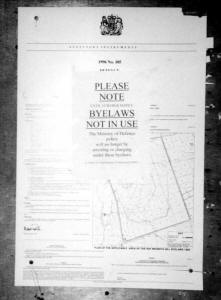
On 4 September 1996 at Harrogate
Magistrates’ Court they were convicted by Stipendary Magistrate Mr
Neville White and sentenced to 2 years conditional discharge. The
defendants appealed to the Crown Court and obtained witness
summonses for the Prime Minister (John Major), the Secretary of
State for Defense (Michael Portillo), the Home Secretary (Michael
Howard), the ex-Secretary of State for Defence (Malcolm Rifkind),
the US Base Commander, the "RAF Commander" and the chief executives
of British Telecomm, Mercury Communications and Vodaphone. However,
none of these actually ever appeared in person.
Eventually, on Friday 5 September 1997
Judge Crabtree [74] at York Crown Court upheld the appeal and judged
the military byelaws invalid because they took in land which was not
being using for military purposes. Evidence extrapolated by Duncan
Campbell from BT’s letter to the court, showed that the base is now
capable of sending back to the US two million intercepts per hour,
this could be a fraction of the total number of intercepts made -
only those thought to be of further interest are passed on. The
judge accepted that probably the Interceptions of Telecommunications
Act was being violated, as it is unlikely that the Home Secretary
can issue two million warrants per hour! The judge also condemned BT
for revealing confidential arrangements made with the NSA for the
connection in 1992 of 3 (now 4) digital optical fibre cables -
capable of carrying more than 100,000 telephone calls and other
messages - to Menwith Hill.
However, the judge was also of the opinion that, even if the US and
UK were involved in "dishonest activities, they should be allowed to
remain secret." [75]
In the same court case Tony Benn MP (formerly Secretary of State for
Energy and responsible for the UK Nuclear Power programme) testified
that Britain is under contract to the US to buy nuclear weapons on
the condition that bases like Menwith are allowed to operate from
here and on condition that the US controls and has access to all
British intelligence operations.
The Ministry of Defense appealed against the 1997 Crabtree decision
and this appeal was upheld on 22 January 1999 in the High Court,
London, by Judges Buxton and Collins
[76]. They should have sent the
original Appeal against MHS byelaws convictions by Anne Lee and
Helen John (Menwith Women’s Camp) back to the Crown Court to be
dismissed and to have both women’s convictions re-instated
[77].
After losing in the High Court, the two women notified the Ministry
of Defence lawyers that they did not intend to appeal to the House
of Lords, but wished to introduce a new line of argument in the
lower courts (to examine the powers granted to the Defence Secretary
under the Military Lands Act, 1892 - it would be an abuse of process
to use an Act of Parliament for a purpose for which it was not
intended).
Following the Crabtree ruling, in April 1998 , Lindis Percy was
found to be 9 times in breach of the terms of her permanent
injunction at Menwith Hill by Judge Carnwath
[78] in the High Court
for the unlawful use of the footpath i.e. taking down the declared
invalid byelaws signs. Referring to the earlier ruling of Judge
Crabtree, Judge Carnwath said, "I cannot conclude that her stance
was wholly untenable." He also said,
"What cannot be
constitutionally acceptable, in my view, is for the Executive to
proceed as though it were simply free to disregard a decision of a
competent court with which it does not agree ...", he went on to
say, "... there was no legal justification for the retention of the
byelaw notices; it is an abuse of that power, and therefore
unlawful, to put up or maintain notices of bye-laws which are known
to be invalid."
Judge Carnwath reimposed a six month suspended
prison sentence over one year as from that date.
Despite this, byelaws notices were still put up around the base.
This did not stop the action against the byelaws, however. In 1999
Lindis Percy was found ’in contempt of court’ for being in breach of
her permanent injunction at Menwith Hill and sent to prison for 9
months for continuing to pursue her actions against the byelaws.
After her release from prison at the end of July she continued to
challenge the byelaws by walking on a corner of the base.
In September 1999 the Crown Prosecution Service discontinued all
outstanding pre-appeal byelaws charges (74 cases against 35 women).
Although there have been a number of arrests for breach of the
byelaws by several women (who are attempting to challenge their
validity in the courts), the Crown Prosecutor has refused to pursue
them to trial. In March 2000 , the Crown Prosecutor stated,
"I am not prepared to prosecute you
for the purposes of providing a test case under the byelaws …"
[79].
So, now on the one hand the Ministry of
Defence Police (MDP) insist that the byelaws are valid and in force
- on the other hand they are refusing to charge peaceful
’trespassers’ who are in breach of them. There seems to be a
deliberate policy by the MDP to prevent cases coming to court,
thereby denying the citizen the right to challenge the validity of
the byelaws again.
July 4th - Independence from America
Day Protests
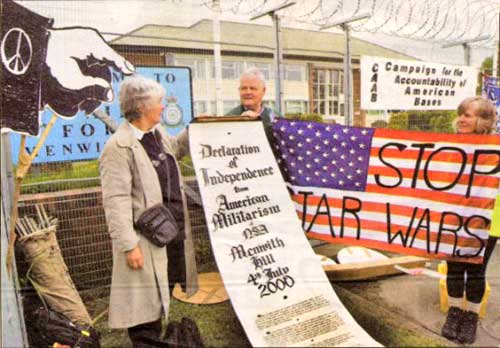
(picture by Steve Riding from
Yorkshire Evening Post 5/7/00)
Former CND chair Buce Kent flanked by
Chrisitne Dean and Lindis Percy at the Menwith Hill base during the
"Independence FROM America" protest on July 4th 2000. July 4th
demonstrations organized by the Campaign for the Accountability of
American Bases (CAAB) have become an annual event at Menwith Hill -
see reports for 1999 , 2000 , 2001 and 2002 also see details for the
2003 demonstration .
On 13 December 2000 (the night George W Bush was confirmed as
President) Anni Rainbow and Lindis Percy were arrested for
obstructing cars leaving Menwith Hill at the Main entrance. One
month later Lindis was also charged with a ’racially motivated’
offence under the Crime and Disorder Act for allegedly ’trailing the
US flag on the ground - forcing an American to drive over the flag’.
She was also charged with a similar offence under the Public Order
Act (minus the ’racial’ element). However, ten days before the trial
was due the Crown Prosecution Service discontinued the ’racially
aggravated’ charge. After a three day trial, on 27 April 2001 , Anni
and Lindis were found not guilty of ’obstruction of the highway’.
Peter Nuttall, the District Judge, ruled that they were not on the
public highway as the area was judged to be part of the ’applicable
area’ of the Military Land byelaws and they were therefore on
private land.
Lindis was also cleared of the Public Order Act offence and the
court heard that Ministry of Defence Police had sent emails to US
personnel on the base asking if they had found it insulting that she
had stood in front of traffic holding a US flag with ’STOP STAR
WARS’ written on it. Rajiv Menon (acting for Lindis) said that the
prosecution was based on evidence from three American zealots and
stated "We would not be here if it was not for a highly politically
motivated prosecution - some might say with the support of the
American military". In his ruling the District Judge said "We do
have rights as citizens and they include the right to protest.
Nobody could say that this was other than peaceful protest".
However, in a strange twist of justice - on 18 May 2001 Lindis was
found guilty of obstruction and an offence under the Public order
Act for holding the same peaceful witness and protest (using the US
flag with ’STOP STAR WARS’ on it) at the Deep and Near Space
Tracking Facility at Feltwell, Norfolk on 16 December 2000 [80]. The
District Judge (Patrick Heley) ruled that there was no breach of the
Human Rights Convention (Article 10 and 11). He made it clear that
there was a balance to be made between the right to protest and the
rights of the Americans to be protected from insult and abuse of
their symbol. Lindis was fined £200 for the Public Order offence,
£100 for ’obstruction of the highway’ and ordered to pay £250 costs.
Lindis had also expressed criticism of the decision of the court and
how his ruling effectively decided in future what symbols would be
acceptable in any peaceful protest. As a result she was later fined
£250 for being ’in contempt of court’. She will be appealing the
decisions of Patrick Heley [81].
The byelaws cases have provided an unprecedented opportunity to
expose the connivance of the UK State Legislative/Executive/
Judicial structures with the Pentagon in support of US bases in the
UK.
On 24 February 1999 Menwith Hill was featured on Channel 4
Television in the UK by the comedian and political
activist/commentator Mark Thomas [82]. The show included a balloon
ride over Menwith by Mark and his team and an overt "surveillance"
of the American Embassy in London. Mark Thomas was also master of
ceremonies on 26 October 1998 when Privacy International presented
the first ’Big Brother Lifetime Achievement’ award to Menwith Hill.
At the same event Lindis Percy of CAAB was awarded the ’Winston
Lifetime Achievement’ for her continued campaigning against Menwith
Hill and similar bases in the UK[83].
 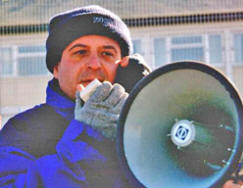 
4th March 200
demonstration at Menwith Hill - pictures from CAAB web-site [84]
Demonstrations and protest actions at the base continue. A Quaker
Meeting for Worship is held bimonthly and hosted by CAAB
[85] who
also maintain an annual 4 July Independence from America Day Protest
[86]. On 4 March 2000 , CAAB and Yorkshire CND organized a national
demonstration at Menwith Hill to draw attention to its role as a
part of the US "Star Wars" system
[87] and on 7 October 2000 a
demonstration was held there by CAAB as one of the 63 actions in 16
countries which formed the "International Day of Protest against the
Militarisation of Space" organized by the Global Network Against
Weapons and Nuclear Power in Space. [88]
On 19 June 2000 (the 3rd anniversary of the US Department of Defense
submission of plans for SBIRS) Anne Lee, Helen John and
Angie Zelter
from the Women’s Peace Campaign were arrested by MoD police after
breaking into the base (through the new high-security, alarmed
perimeter fence erected to protect the new developments) to
highlight the vulnerability of the base to terrorist attacks and to
oppose the use of the base for "Star Wars"
[89].
In August 2000 Anne Lee had her bail varied to allow her to take a
local government watchdog to see the rare orchids growing at the
base and she filed a complaint against the local council, accusing
them of being negligent over conservation of the orchids. This site
has always been known as an area which contained fauna and flora of
special scientific interest - a wetland site - and the fight to
preserve the rare flowers had been going on since the 1980s when
Hazel Costello of OPAG contacted Harrogate Naturalist Society to
preserve the site. Anne Lee had raised the issue of the preservation
of the orchids in July 1998 [90].
In fact, the construction of the
perimeter security fence towards the end of 1999 had been held up
for nearly a year while an expert on orchids from the Royal Botanic
Garden in Edinburgh (Dr Richard Bateman) inspected and assessed the
flowers in bloom in a corner of the base
[91]. The MOD (on behalf of
the Americans) were forced to reroute the fence-line so as to avoid
damaging the orchid reserve.
The trial of Helen John, Anne Lee and Angie Zelter took place on 30,
31 October and 15 December 2000 . The defendants admitted their
action, stating that it was justified because the fence has been
erected to protect Echelon & Star Wars and that, if the owners of
the fence (the UK government, i.e. the British people) were aware of
the crimes it is designed to conceal, they would approve of the
defendants’ act. The women were able to present evidence to justify
their action - this included showing the TV programmes ("The Hill"
produced by Duncan Campbell in 1993 and "Uncle Sam’s Eavesdroppers"
produced by Richard Sadler in 1998 ) and a great deal of recently
published material.
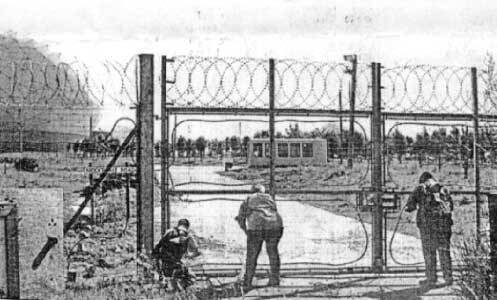
Picture from
Wharfedale Newspapers, June 22 2000 [92]
In summing up, District Judge Browne
stated that it was incumbent on the defendant to prove that this was
their state of mind at the time the act was committed - however, the
’burden of proof’ is on the prosecution to prove otherwise. The
judge ordered a re-trial and on 3 May 2001 all three were found
guilty District Judge Alderson said she would insist on a custodial
sentence for the £962 of damage [93] and the women were in fact
sentenced on 21 May.
Helen John and Anne Lee were given three
and two months imprisonment respectively. Angie Zleter was not
sentenced as she was not present in court and a warrant was issued
for her arrest. At that time Helen John had declared herself an
independent candidate in the General Election standing against Tony
Blair in his Sedgefield constituency on a "No Star Wars" platform.
The sentences were unusually harsh as in cases of this kind the
English and Scottish courts would normally impose a fine relating to
the amount of damage. If peace protesters refuse to pay on grounds
of conscience, the courts would then sentence them to a term of
imprisonment which, in England, would be two weeks for damage under
£500 [94].
Judge Alderson said she believes that the women believe they acted
in the best interests of society, and to protect society but they
had broken the law and she was giving a harsh sentence because she
wanted to deter Helen, who had 32 previous convictions, and Anne,
who had four. However, both women said they would go on campaigning
at the base - in fact Helen was amused by the idea that a prison
sentence would serve as a deterrent when such an important issue was
at stake [95].
In 2000 the Women’s Peace Camp also referred a large catalogue of
complaints about the base to the Local Government Ombusdsman.
Included in the submission was material to evidence that the ’Star
Wars’ developments were going ahead without the approval of the UK
Parliament, that ECHELON activities contravened national and
international laws and that considerable environmental damage had
been effected by the base (including a detrimental impact on the
Orchid Reserve). However, the Ombudsman stated that she had no
authority to deal with any of these complaints and recommended that
a case against the Ministry of Defense be taken to the Parliamentary
Ombudsman. This is further confirmation that there is no official
oversight of any of Menwith Hill’s activities.
In May 2001 a small international demonstration (along the road
outside the main base - much restricted due to the foot and mouth
epidemic around that time) [96] was held as part of the
Global
Network Against Weapons and Nuclear Power in Space Conference
against Star Wars and its Annual General Meeting, which was hosted
by Yorkshire CND in Leeds. The Conference included speakers and
workshops on Menwith Hill and its role in Star Wars and also on
Echelon [97].
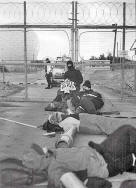 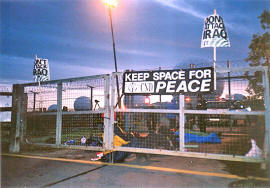
Peace
protesters blockaded the base for 5 hours on 24 October 2002.
Despite being given Aggravated Trespass
notices, no arrests were made and the protesters left with their
locks and banners in hand.
The protesters blocked the only two working entrances to the base
and, whilst the police managed to open a small farm gate to allow
some traffic in, vehicles had to cross two fields in order to enter
the base proper. Only essential staff were allowed in to the base
today – all contractors were turned away.
The non-violent blockade by an independent group of protesters was
an attempt to shut down the base as it prepared for the war on Iraq
war. The blockade aims to disrupt work to pinpoint potential targets
in Iraq currently taking place within the base.
Menwith Hill’s main entrance was closed off at the time for
’essential maintenance work’ by concrete blocks and razor wire.
Using D-locks, Tripods and chains the protesters blocked the two
side entrance gates (Nessfield gate and Steeplebush gate on the B
road off the A59) being used whilst the repairs take place. By
blocking the entrances just before the next staff change-over the
protesters stopped the work of the base in very real, practical
terms, and in doing so, stopped the base’s war preparations.
See report and item from ’The Guardian’ .
On 12 December 2002 the Women’s Peace Campaign organized a "Embrace
the Base" women only demonstration to remember and celebrate the
empowerment of the 30,000 women who demonstrated against the USA’s
Cruise Missiles at Greenham Common in the same day in 1982.
On 22 March 2003 over a thousand people joined a ’Foil the Base’
protest against the bases involvement in the war on Iraq. Despite a
massive police presence many people entered the base and there were
12 arrests (most released without charge).
 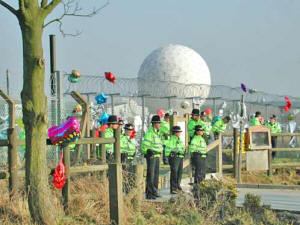
On 4 July 2003 about 400 people joined a
’Gatecrasher’s Ball’ demonstration calling for "Independence From
America" protest against the bases involvement in the war on Iraq.
Despite a massive police presence many people entered the base and
there were 12 arrests (most released without charge). Mark Thomas
was Master of Ceremonies once more suitably dressed for a Ball.
Unfortunately there was a heavy police presence and some unpleasant
scenes - see ’CAAB report .
Weekly Demonstrations
The Campaign for the Accountability of American Bases (CAAB)
continue to hold weekly demonstrations on a Tuesday from 7-9pm
outside the base in all weathers and throughout the year.
Go Back
|

 Our
SBIRS system consolidates DoD’s
non-imaging infrared systems that fulfill national security
needs in areas of missile warning, missile defense, technical
intelligence and battlespace characterization. It consists of
high and low components. We need to get SBIRS High on-orbit
first as a replacement for the Defense Support Program (DSP).
We’re going to put four satellites up to replace four DSPs.
Our
SBIRS system consolidates DoD’s
non-imaging infrared systems that fulfill national security
needs in areas of missile warning, missile defense, technical
intelligence and battlespace characterization. It consists of
high and low components. We need to get SBIRS High on-orbit
first as a replacement for the Defense Support Program (DSP).
We’re going to put four satellites up to replace four DSPs.


 is
now claiming £16,173.06p costs and the 2/3/4 Defendants are claiming
£11,000 costs against Lindis. However, CAAB will still continue with
this action, and Fylingdales was later included in the Claim as
another base to be used as part of ’Son of Star Wars’
[59].
is
now claiming £16,173.06p costs and the 2/3/4 Defendants are claiming
£11,000 costs against Lindis. However, CAAB will still continue with
this action, and Fylingdales was later included in the Claim as
another base to be used as part of ’Son of Star Wars’
[59]. 
 raising
public awareness and protest at MHS in the 1980s) on 29 April 1983 .
At least 10 other weekend mixed peace camps were held at MHS by
other local peace groups.
raising
public awareness and protest at MHS in the 1980s) on 29 April 1983 .
At least 10 other weekend mixed peace camps were held at MHS by
other local peace groups. 














